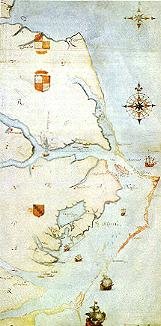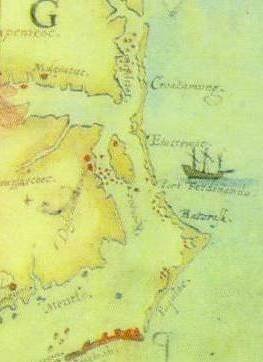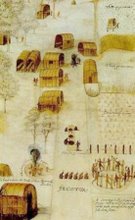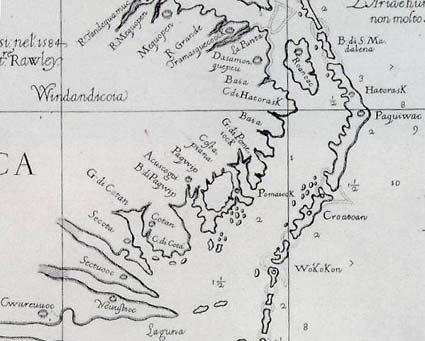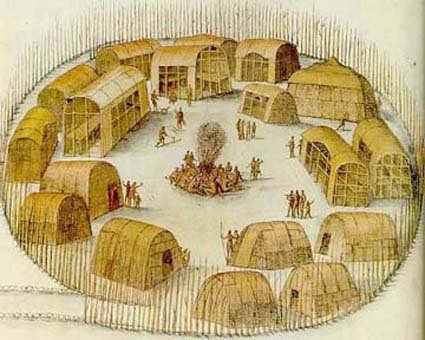MORGANTON - People gathered around a woman and shouts of "hey, hey, hey" went up at the Berry archeological site on Thursday.
David Moore, lead archeologist at the site, was standing about 75 yards away. When he heard the shouts, he made his way over to the group.
What got the crowd excited was a find by Jeane Jones, of Dalton, Ga., of a tiny blue Spanish glass bead believed left behind from the first European settlement in the interior of what is now the United States.
It was the second glass bead found last week. One man found a piece of metal believed to be from the same era.
On July 12, the public will get a chance to take a look at the glass beads and other artifacts found at the site, as well as observe archaeologists at work. Archaeologists will be on hand to discuss the site and lead tours. Primitive skills experts also will demonstrate how native people crafted their weapons and tools.
Warren Wilson College and Western Piedmont Community College Archaeology Field School is sponsoring the open house.
Full Article Here:
http://www.morganton.com/servlet/Satellite?pagename=MNH/MGArticle/MNH_BasicArticle&c=MGArticle&cid=1173355790954
Showing posts with label piedmont. Show all posts
Showing posts with label piedmont. Show all posts
Friday, July 11, 2008
Public invited to see 500-year-old artifacts This Saturday
Posted by
Historical Melungeons
at
7/11/2008 03:20:00 PM
![]()
Labels: Archaeology, piedmont, Spanish
Sunday, May 25, 2008
North Carolina: In the Beginning
Time Before History
Book Review
North Carolina's written history begins in the sixteenth century with the voyages of Sir Walter Raleigh and the founding of the ill-fated Lost Colony on Roanoke Island. But there is a deeper, unwritten past that predates the state's recorded history. The region we now know as North Carolina was settled more than 10,000 years ago, but because early inhabitants left no written record, their story must be painstakingly reconstructed from the fragmentary and fragile archaeological record they left behind.Time before History is the first comprehensive account of the archaeology of North Carolina. Weaving together a wealth of information gleaned from archaeological excavations and surveys carried out across the state—from the mountains to the coast—it presents a fascinating, readable narrative of the state's native past across a vast sweep of time, from the Paleo-Indian period, when the first immigrants to North America crossed a land bridge that spanned the Bering Strait, through the arrival of European traders and settlers in the sixteenth and seventeenth centuries.
Google Books
TIME BEFORE HISTORY by H. Trawick Ward reviews what archaeologists know about the ancient history of native North Carolina from the original settlement of its Appalachian mountain ranges, its Piedmont region, and its coastal provinces some twelve thousand years ago until the encounters between native peoples and European American explorers, traders, soldiers, and settlers from the 1500s through much of the 1700s. The photos of artifacts and scenes from archaeological fieldwork complement well its chapters about native cultures during different periods of the past. Maps and other line drawings are good contributions to the book. Certainly, the book will appeal to archaeologists and historians interested in native peoples of eastern North America. Meanwhile, its lively prose is accessible to any other readers interested in the culture and history of native peoples in North Carolina.
The first chapter outlines the major characteristics of architecture and other artifacts from North Carolina during different periods of the past, as they are currently understood by archaeologists. The authors then trace the history of North Carolina archaeology, from the late 19th century to current problems and prospects for the practice of prehistoric archaeology here at the end of the 20th century.
The second chapter reconstructs the lives of the groups to which archaeologists refer as Paleoindian people, the mobile bands of hunters and gatherers who settled North Carolina between 9500 and 7900 BC, and whose presence here is reflected primarily by certain kinds of stone spearheads. Just when the original North American settlers arrived and what their lives were like are currently very hot topics in archaeology, but it is clear that ten thousand years ago, native North Carolinians were living in colder and drier woodland environments than are here today.
Continued here
Book Review
North Carolina's written history begins in the sixteenth century with the voyages of Sir Walter Raleigh and the founding of the ill-fated Lost Colony on Roanoke Island. But there is a deeper, unwritten past that predates the state's recorded history. The region we now know as North Carolina was settled more than 10,000 years ago, but because early inhabitants left no written record, their story must be painstakingly reconstructed from the fragmentary and fragile archaeological record they left behind.Time before History is the first comprehensive account of the archaeology of North Carolina. Weaving together a wealth of information gleaned from archaeological excavations and surveys carried out across the state—from the mountains to the coast—it presents a fascinating, readable narrative of the state's native past across a vast sweep of time, from the Paleo-Indian period, when the first immigrants to North America crossed a land bridge that spanned the Bering Strait, through the arrival of European traders and settlers in the sixteenth and seventeenth centuries.
Google Books
TIME BEFORE HISTORY by H. Trawick Ward reviews what archaeologists know about the ancient history of native North Carolina from the original settlement of its Appalachian mountain ranges, its Piedmont region, and its coastal provinces some twelve thousand years ago until the encounters between native peoples and European American explorers, traders, soldiers, and settlers from the 1500s through much of the 1700s. The photos of artifacts and scenes from archaeological fieldwork complement well its chapters about native cultures during different periods of the past. Maps and other line drawings are good contributions to the book. Certainly, the book will appeal to archaeologists and historians interested in native peoples of eastern North America. Meanwhile, its lively prose is accessible to any other readers interested in the culture and history of native peoples in North Carolina.
The first chapter outlines the major characteristics of architecture and other artifacts from North Carolina during different periods of the past, as they are currently understood by archaeologists. The authors then trace the history of North Carolina archaeology, from the late 19th century to current problems and prospects for the practice of prehistoric archaeology here at the end of the 20th century.
The second chapter reconstructs the lives of the groups to which archaeologists refer as Paleoindian people, the mobile bands of hunters and gatherers who settled North Carolina between 9500 and 7900 BC, and whose presence here is reflected primarily by certain kinds of stone spearheads. Just when the original North American settlers arrived and what their lives were like are currently very hot topics in archaeology, but it is clear that ten thousand years ago, native North Carolinians were living in colder and drier woodland environments than are here today.
Continued here
Posted by
Historical Melungeons
at
5/25/2008 12:55:00 PM
![]()
Labels: american indian, appalachian, Archeology, Native American, north carolina, paleoindian, piedmont
Subscribe to:
Posts (Atom)



